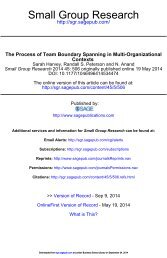A Dynamic Perspective on Diverse Teams: Moving From The Dual Process Model to A Dynamic Coordination-Based Model of Diverse Team Performance - Kannan Srikanth, Sarah Harvey & Randall Peterson
The existing literature on diverse teams suggests that diversity is both helpful to teams in making more information available and encouraging creativity and damaging to teams in reducing cohesion and information sharing. Thus the extant literature suggests that diversity within teams is a double-edged sword that leads to both positive and negative effects simultaneously.
The existing literature on diverse teams suggests that diversity is both helpful to teams in making more information available and encouraging creativity and
damaging to teams in reducing cohesion and information sharing. Thus the
extant literature suggests that diversity within teams is a double-edged sword
that leads to both positive and negative effects simultaneously.
You also want an ePaper? Increase the reach of your titles
YUMPU automatically turns print PDFs into web optimized ePapers that Google loves.
A <str<strong>on</strong>g>Dynamic</str<strong>on</strong>g> <str<strong>on</strong>g>Perspective</str<strong>on</strong>g> <strong>on</strong> <strong>Diverse</strong> <strong><strong>Team</strong>s</strong> † 11<br />
Downloaded by [L<strong>on</strong>d<strong>on</strong> Business School Library], [<strong>Randall</strong> Peters<strong>on</strong>] at 06:11 31 January 2016<br />
dependent and independent variables in a study, yet remain invisible in an<br />
aggregated study (Mitchell & James, 2001). For example, whereas group diversity<br />
has been associated with beneficial task outcomes, intervening processes<br />
like informati<strong>on</strong> elaborati<strong>on</strong> are the causal media<strong>to</strong>rs <strong>of</strong> those outcomes. To<br />
develop a complete understanding <strong>of</strong> any group process, it is therefore necessary<br />
<strong>to</strong> c<strong>on</strong>sider both the way that the process is reflected in a generalized group<br />
envir<strong>on</strong>ment over some period <strong>of</strong> time, and the specific group member behaviors<br />
that create that envir<strong>on</strong>ment in the shorter term. That requires explicit<br />
attenti<strong>on</strong> <strong>to</strong> the temporal horiz<strong>on</strong> over which effects are measured.<br />
Applying the <str<strong>on</strong>g>Dynamic</str<strong>on</strong>g> <str<strong>on</strong>g>Perspective</str<strong>on</strong>g> <strong>to</strong> Existing Research <strong>on</strong> <strong>Diverse</strong> <strong><strong>Team</strong>s</strong><br />
A relatively small but growing number <strong>of</strong> studies in the team diversity literature<br />
have begun <strong>to</strong> incorporate time as an explicit variable in their models <strong>of</strong> diverse<br />
team performance. This research has dem<strong>on</strong>strated that the effects <strong>of</strong> both<br />
surface and deep-level diversity are different over different time frames than<br />
studies typically allow for (Harris<strong>on</strong> et al., 1998, 2002, 2003; Pelled, Eisenhardt,<br />
& Xin, 1999). In particular, those studies reveal that over time, the negative<br />
effects <strong>of</strong> surface-level diversity can be attenuated, whereas the positive<br />
effects <strong>of</strong> deep-level differences may reduce in highly collaborative groups.<br />
Those findings hint at the possibility that both the negative c<strong>on</strong>sequences <strong>of</strong><br />
social categorizati<strong>on</strong> processes and the positive c<strong>on</strong>sequences <strong>of</strong> informati<strong>on</strong>al<br />
diversity may be exaggerated in the existing literature; or that the relati<strong>on</strong>ship<br />
between those c<strong>on</strong>structs is not yet fully unders<strong>to</strong>od.<br />
Diversity scholars have yet <strong>to</strong> develop a dynamic perspective <strong>on</strong> the dualprocess<br />
model explaining how the benefits from informati<strong>on</strong>al diversity and<br />
problems stemming from demographic diversity may relate <strong>to</strong> <strong>on</strong>e another<br />
over time. We suggest that the next step <strong>to</strong> developing a better understanding<br />
<strong>of</strong> diverse teams performance is <strong>to</strong> examine teams through a temporal lens.<br />
Specifically, we propose comparing studies c<strong>on</strong>ducted over l<strong>on</strong>ger periods <strong>of</strong><br />
group work with those that capture more micro-processes that occur in the<br />
very early period <strong>of</strong> group interacti<strong>on</strong>. <strong>The</strong> model illustrated in Figure 1, in<br />
which diversity acts as a double-edged sword, is based <strong>on</strong> and supported by<br />
studies that examine the effects <strong>of</strong> diversity over relatively l<strong>on</strong>g periods (i.e.<br />
weeks and m<strong>on</strong>ths). When a shorter time frame is c<strong>on</strong>sidered in studies <strong>of</strong><br />
diverse groups, however, different interpers<strong>on</strong>al and informati<strong>on</strong>al group processes<br />
have been observed. We review l<strong>on</strong>g-term and short-term studies below.<br />
In so doing, we reveal an emerging alternative understanding <strong>of</strong> the effects <strong>of</strong><br />
group diversity—in particular based <strong>on</strong> studies <strong>of</strong> more micro-group processes<br />
occurring in the very early stages <strong>of</strong> group interacti<strong>on</strong>s.<br />
Applying the dynamic perspective as a lens for reviewing existing studies <strong>of</strong><br />
diverse teams reveals new insights in<strong>to</strong> how group compositi<strong>on</strong> influences<br />
group processes and outcomes through the three mechanisms proposed
















